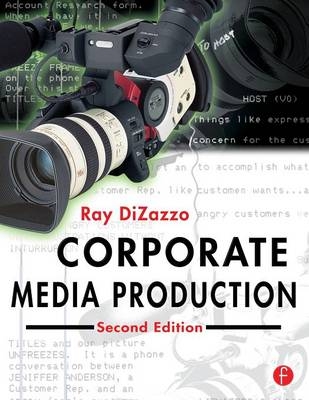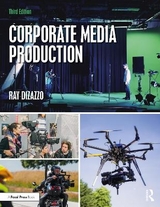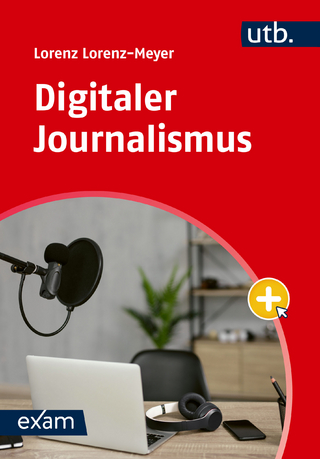
Corporate Media Production
Focal Press (Verlag)
978-0-240-80514-6 (ISBN)
- Titel erscheint in neuer Auflage
- Artikel merken
With the advent of affordable equipment, there are more opportunities than ever in the field of corporate media production. This book examines all aspects of this creative field, from concept development to the final stages of postproduction. The book also clarifies the roles of the writer, producer, director and client while focusing on the dynamics among these key players. This in-depth book captures all the technical and creative elements used in the creation of media in the corporate world.
The new edition has been updated to reflect the most current media production, editing, delivery formats and processes, with an emphasis on DV. There is material on the new digital video cameras and non-linear editing systems, as well as an expanded discussion of audio sweetening. A new chapter on evaluation demystifies this critical process, and there is a new discussion of multimedia.
Ray DiZazzo is an award-winning writer, producer, and director with many years of experience in the corporate venue. He is President of DiZazzo Communications, an independent media company that has created programs for large corporations such as J.D. Power and Associates, GTE, and the United Way. In addition to his corporate media work, he writes on the subject and teaches.
Part One: The Corporate Media Evolution
1The Changing Role of Corporate Media
Uses of Media in the Corporate World
Distribution and Delivery Systems
Videocassettes
Corporate Broadcasts
Distance Learning
CD-ROM, DVD, Streaming Video/Audio
Interactivity-A Key
The World Wide Web
Local Area Networks and Intranets
Creative Changes?
2The Key Players
The Corporate Media Producer
Staff and Freelance Producers
Producer "Musts"
The Reward
The Director
A Definition
The Director as an Artist
Not for the Fainthearted
The Reward
The Scriptwriter
The Real Differences
The Working Environment
The Research Factor
Staff and Freelance Writers
Clients
Client Profiles
Busybodies
Instant Decision Makers
Yessirees
Committee Heads
Plain Old Perfect Clients
A Dynamic Relationship
3Media Groups in the Corporate World
Large In-house Media Groups
Advantages and Disadvantages
Small In-house Media Groups
Advantages and Disadvantages
Outside Production Companies
Advantages and Disadvantages
Prosumers
Advantages and Disadvantages
Freelancers
Advantages and Disadvantages
4A Production Overview
Writing
Program Design
Scriptwriting
Preproduction
Budgeting
Talent Auditions and Bookings
Crew Bookings
Equipment Reservations or Rentals
Location and Set Arrangements
Blocking, Storyboards, and Diagrams
Rehearsals and Meetings
Production Scheduling
Production
Location Production
Studio Production
Graphic Arts Production
Audio Production
Postproduction
The Traditional Offline Edit
The Traditional Online Edit
Nonlinear Editing
Audio "Sweetening"
The Traditional Laydown and Layback
Nonlinear Audio Sweetening
Duplication/Distribution
5Production People
The Line Producer
The Production Manager
The Assistant Director (AD)
The Production Assistant (PA)
The Director of Photography (DP) or Videographer
The Camera Operator
The Gaffer
The Grip
The Sound Recordist/Mixer
The Audio Boom Operator
The Floor Manager or Stage Manager
Technical Director (TD)
Videotape Operator (Tape Op)
Video Control Engineer (VC)
Engineer in Charge (EIC)
Teleprompter Operator
The Makeup Artist
Graphic Artist
The Offline Editor
The Online Editor
The Audio Sweetening Engineer
Part Two: The Script
6The Program Needs Analysis
The Scenario of the Unneeded Media Program
Program Design
The Problem or Need
Objectives
Instructional Objectives
Motivational Objectives
Mixing Objectives
Audience Analysis
Audience Size/Discipline
Audience Demographics
Audience Attitudes
Audience Needs/Interest
Audience Knowledge Level
Multiple Audiences
Utilization
Interactive Design
Design Summary
A Complete Program Needs Analysis
Commentary
The Decision
7The Content Outline
Acquiring Content Information
Interview Techniques and Research Sources
Use a Tape Recorder If Possible
Use Open-ended Questions
Guide the Discussion
Insist on Simplicity
Listen
Other Sources
Organizing Content Information
Content Outline Formats
Informal
Formal
Other Structures
A Formal Content Outline
Commentary
8The Creative Concept
Print Versus Visual (Showing Versus Telling)
Telling (Print-Oriented Writing)
Showing (Visual Writing)
The Creative Visual Concept
Types of Concepts
Concept Thinking
Concept Examples
Host on Camera with Slides Transferred to Tape
Music Video
Documentary
Children Interviewed on Clean Air
Concept Summary
9The Treatment
A Definition
Treatment Summary
A Complete Program Treatment
Commentary
10The Script
Formats
The Two-Column Format
The Screenplay Format
Interactive Scripts
Storyboard
Narration Script
11 Script Terminology
Editing Terms
Camera Terms
Scene Heading Terms
Sound Terms
Master Scenes Versus Detailed Descriptions
12Dialogue and Narration
Dialogue Credibility
Natural Speech Patterns
Believable Character Motivation
Use of Contractions and Colloquialisms
The Dialogue Test
Narration
Effective Narration Qualities
Conversational Tone
Content Focus
Simplicity
13Structure and Transitions
Types of Structures
Structure Versus Storyline
Corporate Structures
The Tell 'em Structure
Tell 'em Examples
Benefits Bookends
Contrasting Actions
Creative Use of Structure
14A Screenplay Format Script
Commentary
Part Three: Preproduction: The Plan for Success
15Preproduction
Detail-the Key
The Players
The Client
The Producer
The Director
The Assistant Director
The Production Assistant
Crew Costs
Run 'n' Gun Shoots
Preproduction Tasks
Budgeting
Reviewing and Breaking Down the Script
Creating The Master File
Obtaining Props and Wardrobe
Scouting and Confirming Locations and Obtaining Permits and Releases
Auditioning and Selecting Talent, Professional and Otherwise
Developing and Writing the Shooting Schedule
Hiring the Crew
Designing Sets
Renting or Reserving Production Equipment and Vehicles
Equipment Lists
Designing and Creating Artwork, Animation, and Character-generated Titles
Reviewing and Selecting Stock Footage
Reviewing and Selecting Music
Blocking the Script
Rehearsing
Conducting Preproduction Meetings
Preparing Equipment for the Shoot
Part Four: Production
16Production Formats, Equipment, and Shooting Styles
Glamour or Grind?
The Videotape and Film Recording Processes
Film Recording
Video Analog and Digital Recording
Formats
One-Inch Reel-to-Reel
Three-Quarter-Inch U-Matic
Half-Inch Camcorders
D (Digital) Formats
DV (Digital Video)
Equipment
Cameras
Videotape Recorders (VTRs)
Microphones
Mixers
Monitors
Lights
Lighting Accessories
Other Equipment
Production Styles
Location Shooting
Single-Camera Style
Studio Shooting
Multicamera Style
"Virtual" Production
17A Day on Location and a Day in the Studio
Location Production
Setup
Rehearsal
Take One
The Strike
Small Location Shoots
Studio Production
Rehearsal
Switching Live-on-Tape
Nondramatic Studio Shoots
Smaller Studio Shoots
18Audio Production
Audio Recording in the Studio
The Production Audio Room
The Recording Session
The Audio Script
Transfer to Videotape
Audio Recording on Location
Sync Source
Field or Studio?
The Importance of Sound
Part Five: The Director
19The Director's Role
Illusionism: The Director's Art
Script Aesthetics
Informational Clarity
A Rule of Thumb
Character Profiles
Host Roles
Dramatic or Humorous Roles
Plot and Structure
Structure and Transitions
Tone and Pace
Summary
20Human Aesthetics
Image and Performance-The Critical Ingredients
Casting
Auditions
Appearance ("Look")
Performance Capability
Ability to Take Direction
Personality
Audition Review
Rehearsal
Before the Shoot
Script Discussions
Readings
Blocking
Call at Home
Mail or Fax
Rehearsal on the Set
Give an Initial Scene Overview
Be Specific
Give Specific Changes Now
Provide Encouragement
Break for Discussion if Needed
Be Decisive
Execution
Distractions
Directing Nonprofessional Talent
Use Employees to Demonstrate
Do Not Cast Employees In Character Roles
Do Not Give Employees Scripted Information Lines
Do Employ the News-style Interview
Meet with Employees Before Taping Interviews
Play Down the "Hollywood" Image
Be an Involved Listener
Prepare Interview Questions in Advance
Be Patient
21Audiovisual Aesthetics
Pictures and Sound
Script Analysis and Visualization
Visual Elements
Camera Placement and Movement
Standard Coverage
Editing Coverage
Nonstandard Camera Placement and Movement
Movement
Frame Size
Short Focal Lengths
Mid-range Focal Lengths
Long Focal Lengths
Prime Lenses
Zoom Lenses
Shot Descriptions
Wide Shot (WS)
Medium Shot (MS)
Medium Closeup (MCU)
Closeup (CU)
Extreme Closeup (ECU)
Insert
Avoiding "Jump Cuts"
Change Focal Lengths
Change Camera Positions
Plan Edits Carefully
Frame Composition
Balance
Depth
Mood and Lighting
Sound
Sound Quality
Microphone Choices
Types of Sounds
Summary
22Technical Aesthetics
Avoiding Technical Inaccuracies
Props
Makeup
Wardrobe
Continuity Problems
Physical Continuity
Performance Continuity
Screen Direction
"Sneaking" Across the Line
Summary
23General Aesthetics
A Definition
Tone
Corporate Tone Considerations
Pace
Shot Content
Shot Length
Editing for Pace
Transitions
Use of the Cut
Use of Dissolves
Use of Wipes
Use of Digital Video Effects (DVE)
Summary
24People Skills
The Director as Consultant
The Director as Manager
Planning
Organizing
Confirming
Preproduction Meetings
The Director as Supervisor
Communicate
Be Accessible
Be Decisive
Be Reasonable
Recognize Good Work
Have Fun
Say Thanks
The Director as Coach
Communicating with Actors
Articulating
Allowing Flexibility
Clarifying Motivation
Recognizing the "Real World"
Encouraging Actors
Demanding Excellence
Recognizing Effort
Knowing When to Let Up
Gaining Respect
Coaching Employee Talent
Summary
25Judgment Skills
Sensitivity to the People and the World Around Us
Sensitivity to Audience Tastes
Sensitivity to the Client's and Producer's Tastes
Other Judgment Calls
Judgment Under Pressure
Visual Versus Content
Content Versus Visual
Summary
Part Six: Postproduction
26A Postproduction Overview
Traditional Versus Nonlinear
Traditional Editing Overview
Duplication
The Master Script Package
The Editing Process and Time Code
Time Code and Control Track
27The Traditional Offline and Online Edit
The Offline Edit
The Editor
The Offline
The Editing Process
The Rough-Cut Screening
Additional Notes
The Online Edit
Auto Assemble
Special Effects and Titles
28Nonlinear Editing
A Nonlinear Analogy
The Nonlinear Editing Process
Logging and Digitization
Editing
Titles and Artwork
Client and Producer Review
Output
The Future of Nonlinear Editing
Summary
29Audio Sweetening
The Sweetening Room-Traditional Audio Sweetening
The Laydown, Mix, and Layback
Nonlinear Audio Sweetening
30Why Evaluate
The Evaluation Payback
Feedback and The Need To Improve
Documentation: Ammunition Against Executive Attack
Which Evaluation?
Administering the Evaluation
What Next?
Indices Evaluations
Considerations
A Final Note on Evaluations
31The Future of Corporate Media
Network Media Delivery
Interactivity
Going Global
Distance Learning
Sales and Information Programming on the Nets
A Challenging Tomorrow
Glossary
| Erscheint lt. Verlag | 16.10.2003 |
|---|---|
| Verlagsort | Oxford |
| Sprache | englisch |
| Maße | 216 x 280 mm |
| Gewicht | 688 g |
| Themenwelt | Sozialwissenschaften ► Kommunikation / Medien ► Journalistik |
| Wirtschaft | |
| ISBN-10 | 0-240-80514-3 / 0240805143 |
| ISBN-13 | 978-0-240-80514-6 / 9780240805146 |
| Zustand | Neuware |
| Informationen gemäß Produktsicherheitsverordnung (GPSR) | |
| Haben Sie eine Frage zum Produkt? |
aus dem Bereich



